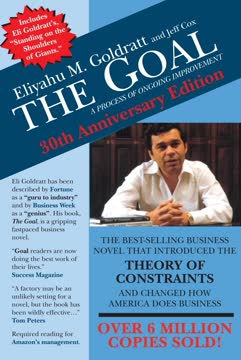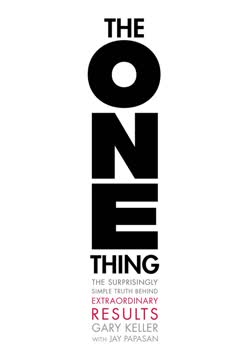نکات کلیدی
1. مدیریت درباره ایجاد مشتری و پیشبرد نوآوری است
تنها تعریف معتبر از هدف کسبوکار: ایجاد مشتری است.
ایجاد مشتری. هدف اصلی یک کسبوکار نه حداکثر کردن سود، بلکه ایجاد و حفظ مشتریان است. این نیازمند تمرکز بر بازاریابی و نوآوری به عنوان دو وظیفه اساسی هر سازمان است. بازاریابی درباره درک و برآورده کردن نیازهای مشتری است، در حالی که نوآوری شامل ایجاد محصولات، خدمات یا فرآیندهای جدیدی است که ارزش افزوده دارند.
پیشبرد نوآوری. نوآوری محدود به توسعه محصول نیست بلکه به تمام جنبههای کسبوکار گسترش مییابد. این شامل یافتن راههای جدید برای دسترسی به مشتریان، بهبود فرآیندهای داخلی و تطبیق با شرایط متغیر بازار است. کسبوکارهای موفق به طور مداوم نوآوری میکنند تا از رقابت جلوتر بمانند و نیازهای در حال تغییر مشتریان را برآورده کنند.
- حوزههای کلیدی نوآوری:
- توسعه محصول و خدمات
- روشهای بازاریابی و توزیع
- ساختار و فرآیندهای سازمانی
- مدلهای کسبوکار و جریانهای درآمدی
2. اهداف و خودکنترلی برای مدیریت مؤثر ضروری هستند
مدیریت بر اساس اهداف و خودکنترلی ممکن است بهطور مشروع به عنوان یک "فلسفه" مدیریت نامیده شود.
اهداف روشن. تعیین اهداف روشن و قابل اندازهگیری برای مدیریت مؤثر حیاتی است. این اهداف باید با اهداف کلی سازمان همسو باشند و بهوضوح به تمام سطوح مدیریت ابلاغ شوند. این رویکرد امکان تصمیمگیری بهتر را فراهم میکند، زیرا مدیران میتوانند انتخابهای خود را بر اساس میزان کمک به دستیابی به اهداف تعیینشده ارزیابی کنند.
خودکنترلی. توانمندسازی مدیران با خودکنترلی به معنای دادن استقلال به آنها برای تصمیمگیری در حوزههای مسئولیتشان است. این حس مالکیت و مسئولیتپذیری را تقویت میکند و به عملکرد بهتر منجر میشود. همچنین نیاز به نظارت مداوم را کاهش میدهد و به مدیران سطح بالاتر اجازه میدهد بر مسائل استراتژیک تمرکز کنند.
- مزایای مدیریت بر اساس اهداف و خودکنترلی:
- بهبود تصمیمگیری
- افزایش انگیزه و مشارکت
- همسویی بهتر اهداف فردی و سازمانی
- استفاده کارآمدتر از زمان و منابع مدیریت
3. مدیران باید مدیریت کنند: تعادل بین برنامهریزی و اجرا
کار مدیر نظارت بر افراد نیست؛ بلکه هدایت آنهاست.
تعادل بین برنامهریزی و اجرا. مدیران مؤثر باید بین برنامهریزی و اجرا تعادل برقرار کنند. در حالی که برنامهریزی برای تعیین جهت و تخصیص منابع حیاتی است، مدیران باید بتوانند آن برنامهها را بهطور کارآمد اجرا کنند. این نیازمند تطبیقپذیری و توانایی تصمیمگیری سریع در مواقع تغییر شرایط است.
تمرکز بر رهبری. نقش اصلی یک مدیر نظارت یا کنترل کارکنان نیست، بلکه هدایت آنها به سوی دستیابی به اهداف سازمانی است. این شامل تعیین یک چشمانداز روشن، ارائه راهنمایی و حمایت، و ایجاد محیطی است که به کارکنان اجازه میدهد بهترین عملکرد خود را ارائه دهند.
- جنبههای کلیدی رهبری مدیریتی:
- تعیین انتظارات و اهداف روشن
- ارائه منابع و حمایت لازم
- ارائه بازخورد سازنده و شناخت
- پرورش فرهنگ بهبود مستمر و یادگیری
4. ساختار مدیریت باید انعطافپذیر و غیرمتمرکز باشد
بهترین ساختار سازمانی آن نیست که به هر کس یک شغل مشخص بدهد، بلکه آن است که به هر کس اجازه دهد حداکثر تلاش خود را بکند.
ساختارهای انعطافپذیر. سلسلهمراتبهای سخت و نقشهای بیش از حد تخصصی میتوانند اثربخشی سازمانی را مختل کنند. در عوض، ساختارهای مدیریتی باید به اندازه کافی انعطافپذیر باشند تا با شرایط متغیر سازگار شوند و امکان همکاری بینوظیفهای را فراهم کنند.
غیرمتمرکزسازی. غیرمتمرکز کردن اختیار تصمیمگیری میتواند به پاسخهای سریعتر و مؤثرتر به تغییرات بازار و نیازهای مشتری منجر شود. این رویکرد مدیران و کارکنان سطح پایینتر را توانمند میکند، نوآوری را تقویت میکند و عملکرد کلی سازمان را بهبود میبخشد.
- مزایای ساختارهای انعطافپذیر و غیرمتمرکز:
- تصمیمگیری سریعتر
- افزایش مشارکت و انگیزه کارکنان
- پاسخگویی بهتر به شرایط محلی بازار
- بهبود نوآوری و حل مسئله
5. توسعه مدیران برای موفقیت بلندمدت حیاتی است
رفاه، اگر نه بقای هر کسبوکاری، به عملکرد مدیران آینده آن بستگی دارد.
توسعه مستمر. سرمایهگذاری در توسعه مدیران در تمام سطوح برای موفقیت بلندمدت هر سازمان ضروری است. این شامل ارائه آموزش، مشاوره و فرصتهای رشد و پیشرفت است.
برنامهریزی جانشینی. سازمانها باید سیستم قوی برای شناسایی و پرورش رهبران آینده داشته باشند. این امر تداوم مدیریت را تضمین میکند و به حفظ فرهنگ و دانش سازمانی در طول زمان کمک میکند.
- جنبههای کلیدی توسعه مدیران:
- برنامههای آموزشی رسمی
- تجربیات یادگیری در حین کار
- مشاوره و مربیگری
- چرخش شغلی و وظایف بینوظیفهای
- برنامههای توسعه رهبری
6. سازمان انسانی کلید عملکرد اوج است
برای اثربخشی، یک سازمان باید بیش از کارآمد باشد؛ باید انسانی باشد.
رویکرد انسانمحور. شناخت عنصر انسانی در سازمانها برای دستیابی به عملکرد اوج حیاتی است. این شامل ایجاد محیطهای کاری است که انگیزه، مشارکت و رضایت شغلی را تقویت میکند.
طراحی شغل. کار باید به گونهای سازماندهی شود که به کارکنان اجازه دهد مهارتها و تواناییهای خود را بهطور مؤثر به کار گیرند. این ممکن است شامل غنیسازی شغل، ساختارهای تیممحور یا رویکردهای دیگری باشد که کار را معنادار و چالشبرانگیز میکند.
- عناصر سازمان انسانی مؤثر:
- ارتباط واضح اهداف و انتظارات
- فرصتهای رشد شخصی و حرفهای
- سیستمهای شناخت و پاداش
- ملاحظات تعادل کار و زندگی
- پرورش حس هدف و تعلق
7. بعد اقتصادی: تعادل بین سود و انگیزه کارکنان
سود توضیح، علت یا توجیه رفتار و تصمیمات کسبوکار نیست، بلکه آزمون اعتبار آنهاست.
سود به عنوان معیار. در حالی که سود تنها هدف یک کسبوکار نیست، به عنوان معیار مهمی برای اثربخشی و پایداری آن عمل میکند. مدیران باید نیاز به سودآوری را با اهداف دیگر، مانند رضایت مشتری، رفاه کارکنان و مسئولیت اجتماعی متعادل کنند.
انگیزه کارکنان. پاداشهای مالی به تنهایی برای انگیزه دادن به کارکنان کافی نیستند. سازمانها باید محیط کاری ایجاد کنند که انگیزه درونی، مانند فرصتهای رشد، شناخت و حس هدف را فراهم کند.
- تعادل بین سود و انگیزه کارکنان:
- جبران و مزایای منصفانه
- پاداشهای مبتنی بر عملکرد
- برنامههای مشارکت در سود یا مالکیت کارکنان
- سرمایهگذاری در توسعه و رفاه کارکنان
- ارتباط شفاف درباره عملکرد و اهداف شرکت
8. نقش سرپرست حیاتی اما اغلب نادرست درک میشود
سرپرست استاد نیست، بلکه معلم، کمککننده و رهبر است.
بازتعریف نقش. نقش سرپرست باید به عنوان تسهیلگر و مربی دیده شود نه ناظر سنتی. این شامل کمک به کارکنان در توسعه مهارتهایشان، حل مشکلات و دستیابی به اهدافشان است.
توانمندسازی سرپرستان. سازمانها باید ابزارها، آموزش و اختیارات لازم را برای سرپرستان فراهم کنند تا در نقشهای خود مؤثر باشند. این شامل اهداف روشن، اختیار تصمیمگیری و حمایت از مدیریت بالاتر است.
- مسئولیتهای کلیدی سرپرستان مؤثر:
- تعیین و ارتباط اهداف تیم
- ارائه بازخورد و مربیگری مداوم
- تسهیل حل مسئله و تصمیمگیری
- ترویج کار تیمی و همکاری
- شناسایی و توسعه استعداد درون تیم
آخرین بهروزرسانی::
FAQ
What's The Practice of Management about?
- Comprehensive Management Overview: The Practice of Management by Peter F. Drucker provides a detailed exploration of management as a distinct and essential function within organizations.
- Historical Context: Written in 1954, the book reflects on the evolution of management thought and practices, positioning management as a critical institution in modern industrial society.
- Focus on Objectives: It introduces the concept of "management by objectives," emphasizing the importance of setting clear goals for effective management and organizational performance.
Why should I read The Practice of Management by Peter F. Drucker?
- Foundational Knowledge: This book is considered a foundational text in management literature, offering insights that remain relevant for both aspiring and seasoned managers.
- Practical Frameworks: Drucker provides practical frameworks and principles applicable across various industries, making it a valuable resource for real-world management challenges.
- Influential Concepts: The ideas presented have influenced generations of managers and continue to shape management education and practice.
What are the key takeaways of The Practice of Management?
- Management as a Discipline: Drucker argues that management requires specific skills and knowledge, distinct from other functions like finance or marketing.
- Importance of Objectives: The book emphasizes the necessity of setting clear objectives to guide decision-making and measure performance effectively.
- Human Element in Management: Understanding the human aspect of management, including motivation, leadership, and organizational culture, is crucial.
What is "management by objectives" as defined in The Practice of Management?
- Goal-Oriented Approach: Management by objectives (MBO) involves managers and employees collaboratively setting clear, measurable goals to enhance organizational performance.
- Self-Control Mechanism: This approach encourages self-control among managers, allowing them to measure their performance against established objectives.
- Performance Accountability: MBO fosters accountability, as managers are expected to take responsibility for achieving the objectives they have helped to set.
How does Peter F. Drucker define the role of management in The Practice of Management?
- Dynamic Leadership: Drucker describes the manager as the "dynamic, life-giving element" in a business, responsible for transforming resources into productive outcomes.
- Distinct Group: Management is portrayed as a distinct and leading group in society, with specific responsibilities that differ from those of labor or capital.
- Economic Performance Focus: The primary role of management is to ensure economic performance, making decisions that drive the organization toward its goals.
What are the challenges to management discussed in The Practice of Management?
- Adapting to Change: Drucker identifies the challenge of adapting to rapid changes in the business environment, including technological advancements and shifting market demands.
- Balancing Short and Long-Term Goals: Managers must navigate the tension between achieving immediate results and planning for sustainable long-term success.
- Managing Human Resources: The book emphasizes the difficulty of effectively managing people, highlighting the need for motivation, development, and a positive organizational culture.
What is the significance of the "Sears Story" in The Practice of Management?
- Case Study of Innovation: The Sears story illustrates how a business can successfully innovate and adapt to meet customer needs, particularly in mail-order retailing.
- Market Analysis: Drucker uses Sears to demonstrate the importance of understanding the market and customer needs, which are critical for business success.
- Management Evolution: The evolution of Sears under different leaders showcases the impact of effective management practices on organizational growth and adaptation.
How does The Practice of Management address the issue of managerial responsibility?
- Span of Responsibility: Drucker introduces the concept of "span of managerial responsibility," emphasizing that managers should assist and teach their subordinates rather than merely supervise them.
- Empowerment: Managers are encouraged to empower their teams by providing the necessary tools and support to achieve their objectives, fostering a culture of growth and development.
- Performance Accountability: The focus is on holding managers accountable for the performance of their teams, ensuring that they are actively involved in their subordinates' success.
What are the best quotes from The Practice of Management and what do they mean?
- Profit and Responsibility: “The enterprise must operate at an adequate profit—this is its first social responsibility.” This quote emphasizes that profitability is essential for a business's survival and its ability to contribute to society.
- Business and Society: “What is good for the business is good for the country.” This statement reflects the idea that successful businesses contribute positively to the economy and society.
- Leadership vs. Boss: “The manager must be a leader, not a boss.” This quote underscores the importance of leadership qualities in management, suggesting that effective managers inspire and motivate rather than simply direct.
How does Peter F. Drucker suggest organizations should handle reports and procedures in The Practice of Management?
- Streamlining Processes: Drucker advises that organizations should regularly evaluate the necessity of reports and procedures, suggesting simplification to focus on key performance areas.
- Trial for Necessity: He recommends putting every form and report "on trial for its life" at least every five years to determine if it is still needed.
- Performance Measurement: Reports should serve as tools for managers to achieve performance, not as measures of their performance, ensuring that the focus remains on results.
How does The Practice of Management define effective management?
- Setting Objectives: Effective management begins with setting clear and achievable objectives that guide the organization’s direction and priorities.
- Organizing Resources: Managers must organize resources efficiently, ensuring that all parts of the organization work together towards common goals.
- Motivating Employees: A key aspect of management is motivating employees, which involves understanding their needs and creating an environment that fosters engagement and productivity.
How does Peter F. Drucker suggest managers should handle change in organizations in The Practice of Management?
- Embrace Change: Drucker emphasizes that managers must be proactive in managing change, viewing it as an opportunity rather than a threat.
- Involve Employees: He advocates for involving employees in the change process to reduce resistance and foster a sense of ownership over new initiatives.
- Continuous Learning: Managers should promote a culture of continuous learning and adaptation, ensuring that the organization remains agile and responsive to external changes.
نقد و بررسی
کتاب عملکرد مدیریت به خاطر بینشهای بیزمان و پوشش جامع اصول مدیریت، تحسینهای زیادی را به خود جلب کرده است. خوانندگان از سبک نوشتاری واضح دراکر، حکمت عملی و ایدههای پیشگامانهای که سالها بعد نیز همچنان مرتبط هستند، قدردانی میکنند. بسیاری این کتاب را متنی بنیادی در نظریه مدیریت میدانند. برخی ممکن است در بخشهایی آن را خشک یا قدیمی بیابند، اما بیشتر افراد بر این باورند که این کتاب درسهای ارزشمندی برای مدیران و رهبران کسبوکار ارائه میدهد. این کتاب به خاطر رویکرد انسانیاش، تأکید بر تعیین اهداف و تمرکز بر توسعه افراد درون سازمانها مورد ستایش قرار گرفته است.
Similar Books























